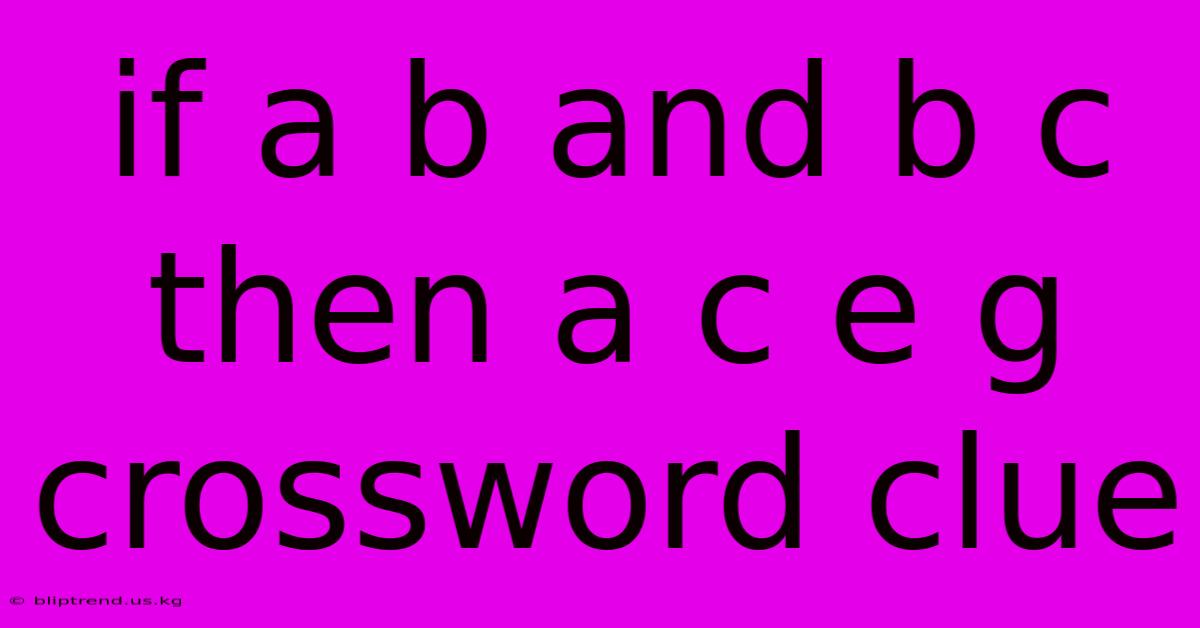If A B And B C Then A C E G Crossword Clue

Discover more in-depth information on our site. Click the link below to dive deeper: Visit the Best Website meltwatermedia.ca. Make sure you don’t miss it!
Table of Contents
Decoding the Logic: "If A B and B C then A C E G" Crossword Clue
This crossword clue, "If A B and B C then A C E G," presents a fascinating challenge that transcends simple vocabulary. It's not about finding a direct synonym; it's about understanding a logical principle and applying it to decipher a coded sequence. The clue hints at a syllogism, a form of logical reasoning, and requires recognizing a pattern or rule to arrive at the answer. Let's break down the problem step by step, uncovering the underlying logic and revealing the solution.
Understanding the Syllogism
The core of the clue lies in the conditional statement: "If A B and B C then A C." This is a classic example of a syllogism, a three-part deductive argument. Let's analyze it:
- Premise 1: A B (A implies B, or A leads to B)
- Premise 2: B C (B implies C, or B leads to C)
- Conclusion: A C (Therefore, A implies C, or A leads to C)
This structure demonstrates transitivity: if A relates to B in a certain way, and B relates to C in the same way, then A relates to C in that same way. The clue cleverly uses this logical framework to conceal a pattern.
Extending the Logic: Beyond A, B, and C
The clue doesn't simply stop at A, C. It adds "E G," significantly changing the nature of the puzzle. The initial syllogism establishes a transitive relationship, but the inclusion of E and G suggests a more complex pattern is at play. To solve this, we need to identify a rule that governs the sequence. We can explore several possibilities:
-
Alphabetical Progression: A, C, E, G. This is the most obvious pattern. The sequence skips every other letter in the alphabet. This pattern is straightforward and easily recognizable.
-
Numerical Representation: Assigning numerical values to letters (A=1, B=2, etc.) might reveal a numerical relationship, but this approach yields no simple, consistent pattern with the given information.
-
Mathematical Operations: Exploring addition, subtraction, multiplication, or other mathematical operations between the letters' positions in the alphabet isn't immediately fruitful.
The Most Likely Solution and Its Justification
Given the simplicity and directness of the clue's structure, the most probable solution hinges on the simple alphabetical progression: A, C, E, G.
The reasoning behind this solution lies in its inherent elegance and conformity to the clue's structure. The clue utilizes a syllogism to set up an expectation of logical deduction; yet the addition of "E G" subtly shifts the focus from strict syllogistic reasoning to recognizing a pattern within a simple, alphabetic sequence. It's a clever way to test both logical thinking and pattern recognition skills.
Why Other Solutions Are Less Likely
While other patterns could be conceived, they lack the elegant simplicity of the alphabetical progression and would likely require more complex explanations or additional information not provided in the clue. A successful crossword clue should be solvable with a reasonable level of effort and insight, without resorting to overly convoluted reasoning.
Expanding on the Concept: Implications for Other Clues
This type of clue exemplifies the power of logic puzzles in cryptic crossword construction. It forces the solver to engage with multiple levels of thinking: recognizing the underlying logical structure, identifying patterns, and applying that knowledge to arrive at a solution. This skill set is highly transferable to other cryptic clues that may involve coded sequences, wordplay, or the application of mathematical or logical principles.
Practical Application and Further Exploration
The solving process for this clue can be applied to other similar cryptic crossword entries. When faced with a clue that presents a seemingly complex sequence or pattern, consider:
- Breaking it down: Analyze the core structure of the clue, identifying any logical frameworks or conditional statements.
- Looking for patterns: Identify recurring sequences, progressions, or relationships between the elements.
- Testing multiple possibilities: Explore various patterns or approaches to find a solution that aligns with the clue's language and structure.
- Considering simplicity: The most likely solution is often the simplest and most elegant, avoiding overly complicated or convoluted reasoning.
In conclusion, the solution to the crossword clue "If A B and B C then A C E G" is most likely AC EG. The clue cleverly uses a syllogism to lead the solver towards a specific type of thinking, then subtly shifts the focus to pattern recognition within the alphabetical sequence. This example underscores the importance of multiple problem-solving approaches and the rewarding challenge presented by well-crafted cryptic crossword clues. It's a testament to the artful blend of logic and linguistics inherent in the cryptic crossword genre.

Thank you for taking the time to explore our website If A B And B C Then A C E G Crossword Clue. We hope you find the information useful. Feel free to contact us for any questions, and don’t forget to bookmark us for future visits!
We truly appreciate your visit to explore more about If A B And B C Then A C E G Crossword Clue. Let us know if you need further assistance. Be sure to bookmark this site and visit us again soon!
Featured Posts
-
Front Spoiler On A Car Crossword Clue
Jan 20, 2025
-
Iowa Town Where Grant Woods American Gothic Is Set Crossword Clue
Jan 20, 2025
-
Event At Which Spectators May Sit On Straw Bales Crossword Clue
Jan 20, 2025
-
Responsibility Lesson For A Child Crossword Clue
Jan 20, 2025
-
Gymnastics Legend Comaneci Crossword Clue
Jan 20, 2025
